Ludovic Ballouard Upside Down and F.P. Journe Vagabondage I Reviewed by Tim Mosso
by Tim Mosso
If you dare to compare, make it apples to apples. Ludovic Ballouard (Brittany) and François-Paul Journe (Marseille) both hail from France. Both found their calling and long-term residence building Swiss watches.
Each designed an edition of the late, great Harry Winston Opus series: Journe (Opus 1) and Ballouard (Opus 13). And for approximately seven years, the two masters were co-workers at Montres Journe.

Ludovic Ballouard Upside Down (left) and F.P. Journe Vagabondage I
Most pertinent to this comparison, both men designed quirky jumping-hour watches.
Journe is a man who needs no introduction to the readers of these pages, but a quick summary can do no harm. After watch school, Journe focused on restorations in his uncle’s Paris-based shop. Following his first personally-constructed pocket watch in 1983 – a tourbillon (!) with a chronometer escapement(!) – Journe spent most of the next two decades delivering private commissions to clients and under-the-table projects to major brands.
Having completed his first wristwatch in 1991 – a tourbillon with a remontoir device – Journe commercialized that watch in 1999 under his own name. He never looked back.
Ballouard attended watch school early but found no local work in his chosen profession. A period as an aircraft service technician kept his mechanical skills fresh while seeking the right opportunity in watches. That chance arrived in the late 1990s with a slot at Franck Muller as an after-sales service leader for complications. In 2001, Ballouard joined Montres Journe and rose to a specialist in chiming watches.
Following a seven-year tenure, Ballouard boldly launched his eponymous brand into the teeth of the Global Financial Crisis.

Ludovic Ballouard Upside Down
The watch here, the Upside Down, is both Ballouard’s first product and his longest-running model.
————————————————————————————————-
————————————————————————————————-

F.P. Journe Vagabondage I
The Vagabondage – subsequently Vagabondage I – was born of 1990s engineering and early 2000s contingency. Journe had designed a private-commission watch dubbed “Carpediem” for a client who desired a wandering hour, and the resulting display drew heavily from Breguet, Audemars Piguet, and Cartier pocket and wristwatches of the 1920s and 30s.
At the same time, Journe had been sitting on a cushion-shaped movement designed for but not used by a corporate client – widely speculated to have been Cartier. Antiquorum asked Journe for a special auction piece that could be sold at the auction house’s 30th anniversary event in 2004.
Given the short timeframe and limited resources, the Vagabondage was born with the unused base caliber and the wandering hour display complication.
This migrating-hour watch earned its moniker for the hobo-like meandering of the hour display. It bears mentioning that the name is intended as an endearing one in the romantic “Arlo Guthrie” sense of the term.
Three pieces in three different gold colors were made for the event, but widespread interest led to 69 “production” examples in platinum and ten more in platinum with set diamonds.
No series of rose gold Vagabondage Is was offered, but two subsequent Vagabondage editions included dual runs of 69 pieces in platinum and 68 in rose gold. Collectors of the later series expressed interest in owning a matching pair of all three editions.
In 2022, Montres Journe obliged these owners with a 68-piece run of Vagabondage I Rose Gold re-editions. Special consideration was given to owners seeking to complete their sets.
To be sure, the Vagabondage I Rose Gold is not identical to the original. The new watch is larger, better detailed, and equipped with a more robust version of the original caliber. It’s not a distinction that’s apparent on the wrist, and only calipers can verify the difference.
————————————————————————————————-
————————————————————————————————-
As with all Vagabondage models, the V1 Rose Gold features no overt branding or maker’s mark on the dial side. Reportedly, the original watch’s repurposed caliber had been designed to fit a client brand’s tolerances for chronometry, and Journe had higher standards for his own watches. As a result, the only branding on the original watch was on its caseback.
While subsequent Vagabondage models – 2022 included – improved their timekeeping properties, the unbranded look became a signature of the series through all editions.
Journe’s Vagabondage case is what collectors describe as a monobloc. It has no separate case and bezel, so the topside aesthetic is seamless. At center, the bouncing balance adds much needed dynamism to the otherwise still dial. Notably, this is one of the few times a Journe wristwatch has emerged without a free sprung balance.
The rotating aperture “captures” the oncoming hour at 12 o’clock on the dial. The combined hour and aperture then migrate 360 degrees while serving as both the hour indicator and the minute hand.
Journe frames the wandering time display with a rose gold surround and polished steel plaques at each corner.
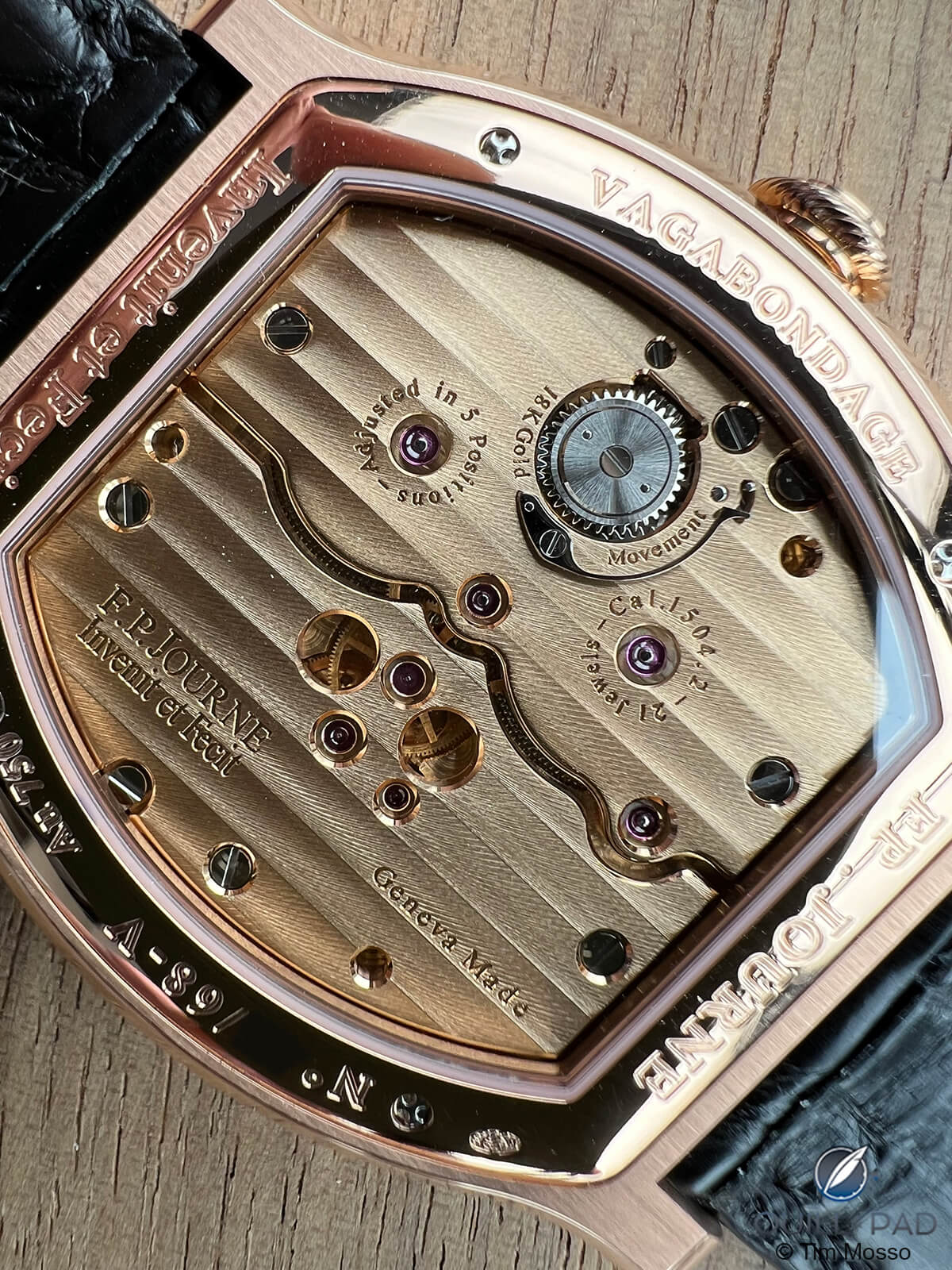
F.P. Journe Vagabondage I movement
On its reverse face, the Vagabondage 1 Rose Gold sports a movement properly sized and shaped for its vessels. As with Audemars Piguet, Jaeger-LeCoultre, H. Moser & Cie, and many other high horology houses of various sizes, Journe practices a combination of hand-finishing and mechanical finishing in order to contain costs. The result is neat and commensurate to price, but it falls just short of the most ornate hand executions.
Machining marks on the bevels betray a mechanized process, screws are polished but not chamfered, and the stripes are neither particularly broad nor luminous. A few small burrs stand alongside the rims of the jewel sinks.
————————————————————————————————-
————————————————————————————————-
However, the use of 18-karat rose gold bridges and plates is exquisite and thrilling; these watches have incredible mass in the hand. A full twenty years after Journe switched from brass to rose gold in his series-built watches, the full gold treatment continues to elicit amazement from newcomers to the brand and satisfaction from veteran collectors.
Journe employs several strategies to improve timekeeping. First, the watchmaker opted for maximum torque. By coupling the twin mainspring barrels in parallel, he ensures twice the force possible with a single barrel or two barrels in series. There’s a note on the bridges concerning five-position adjustment. No such refinement was declared on the 2004 original. Two new jewels reinforce the originals 19, which suggests a more refined mechanism.
Most prominent is the change to the barrel bridge itself. The original Vagabondage I included twin visible ratchet wheels and clicks while the new one cloaks these mechanisms below the bridge.
Ludovic Ballouard works on a scale Journe hasn’t experienced since the very earliest days of his manufacture. Journe’s current declared cap is a maximum of 1,000 mechanical watches per year; quartz is counted separately. Working with just one other watchmaker, Ballouard turns out 12-24 watches per year from his workshop on the outskirts of Geneva.
Production spans only two models (Upside Down and Half Time), and the process is labor-intensive. Unlike Journe, Ballouard encourages and indulges custom options for many – perhaps even most – of his clients. And unlike any Vagabondage edition, the Upside Down remains available as of spring 2024.
At 41mm, the Upside Down is a redoubtable thing for a dress watch. Coming on the back end of the 2000s, it’s understandable how a formal watch launched in that timeframe could be so large. Platinum adds meaty heft to the machine. That said, it’s a gentle giant with a surprisingly compact 47.5mm lug-to-lug span; the compact Vagabondage 1 Rose Gold is barely shorter at 45.2mm.
The case of the Upside Down is exquisite in detail. Its standout feature is a pair of inward curved flanks. Like a concave mirror, the case reflects the image of the viewer in an appropriately “upside down” orientation. The caseback, crown, and even the flank of the pin buckle have all been freehand engraved with a burin.
All of the letters and numbers are unique and beautifully imperfect. An off-center crown with tiny lobes ensures that the Upside Down is equally friendly to left and right-handed owners.
————————————————————————————————-
————————————————————————————————-
The regular production “Petrol Blue” dial of the Upside Down depicted here is as close to stock as Ballouard offers. Eleven numerals sit inverted while one – the current hour – sits upright with a circular marker adjacent. Ballouard intends the system to be received as an expression of his philosophy; live not only for today but for this very moment. In the artist’s view, the present instant is the only one that matters.
Unlike the gradual rotation of the Vagabondage, the jumping action of the Upside Down is instantaneous. Also unlike the Vagabondage 1, the Upside Down takes a moment to comprehend. Its relatively small hour discs and florid font force a short search for the current hour. The current hour’s small marker dot, which is otherwise hidden below the bezel, is the easiest path to reading the time.
Given its polished minute hand on a dark dial, the Upside Down can be confounding to read if you’re in a hurry. Undoubtedly, Ballouard himself would be pleased to see the user make less haste.

Ludovic Ballouard Upside Down movement
While the Ludovic Ballouard caliber B01 is manufactured entirely by the man himself, the fundamental train geometry comes from the well-traveled Peseux 7001. The B01 is built like a donut with the Peseux core recessed within the donut hole. At 23.3mm and 17 jewels, a 7001 is nowhere near the size or complexity of Ballouard’s finished product. Its magic comes from the original elements added by the creator.
Ballouard’s 51-jewel movement spans 35mm; it really spreads its wings amid the circle of 12 Maltese cross jumpers. Above the tractor caliber core, a combination of snail cam, lever, and springs stores and releases the energy to rotate the incoming and outgoing hours every 60 minutes.
There’s a circumferential ring that performs the task; note its serrated edge facing inward towards the jumper lever. The jumper lever is held in tension by the jumper spring, which sits above the crown wheel. This spring provides the energy to rotate the hour ring; the jumper lever collapses into the hollow of the snail cam on one end while it advances the hour ring on the other end.
A tension spring, which overlaps the train and escape wheel bridges, prevents the hour ring from moving in between impulses from the jumper lever.
Finally, the Maltese crosses are attached directly to the underside of the hour discs. The hour ring includes four indexing lobes; look carefully, and you can see two lobes engaged with the current hour’s cross.
There will always be a single lobe present in the prior hour’s cross and the upcoming hour’s cross. Inactive crosses are held in place because the radius of their faces precisely matches the curvature of the hour ring’s outer circumference.
————————————————————————————————-
————————————————————————————————-
Finish is what one would expect from a watch made in less than two dozen examples per year. All bridges feature a fresh and uncommon snailed texture rather than Côtes de Genève. The bevels are broad, round, and mirrored.
Each element of Ballouard’s distinctive jumper system is exquisite, and the acrobatic battery of springs, cam, and lever at center are achingly beautiful under the loupe. Ratchet wheel teeth are individually beveled. Then again, you can do that when you make ~20 watches per year.
In the end, selecting between these watches is a matter of personal taste – for both man and machine. Both Ballouard and Journe have shown me immense respect and consideration in the past, so I can’t say anything less than complimentary about my personal experience with either man. But there’s no denying that Ballouard is quieter and more approachable; he’s as warm as his smile and easy to know.
Journe is a towering figure with the swagger of a tycoon and an intimidation factor if you’re meeting him for the first time.
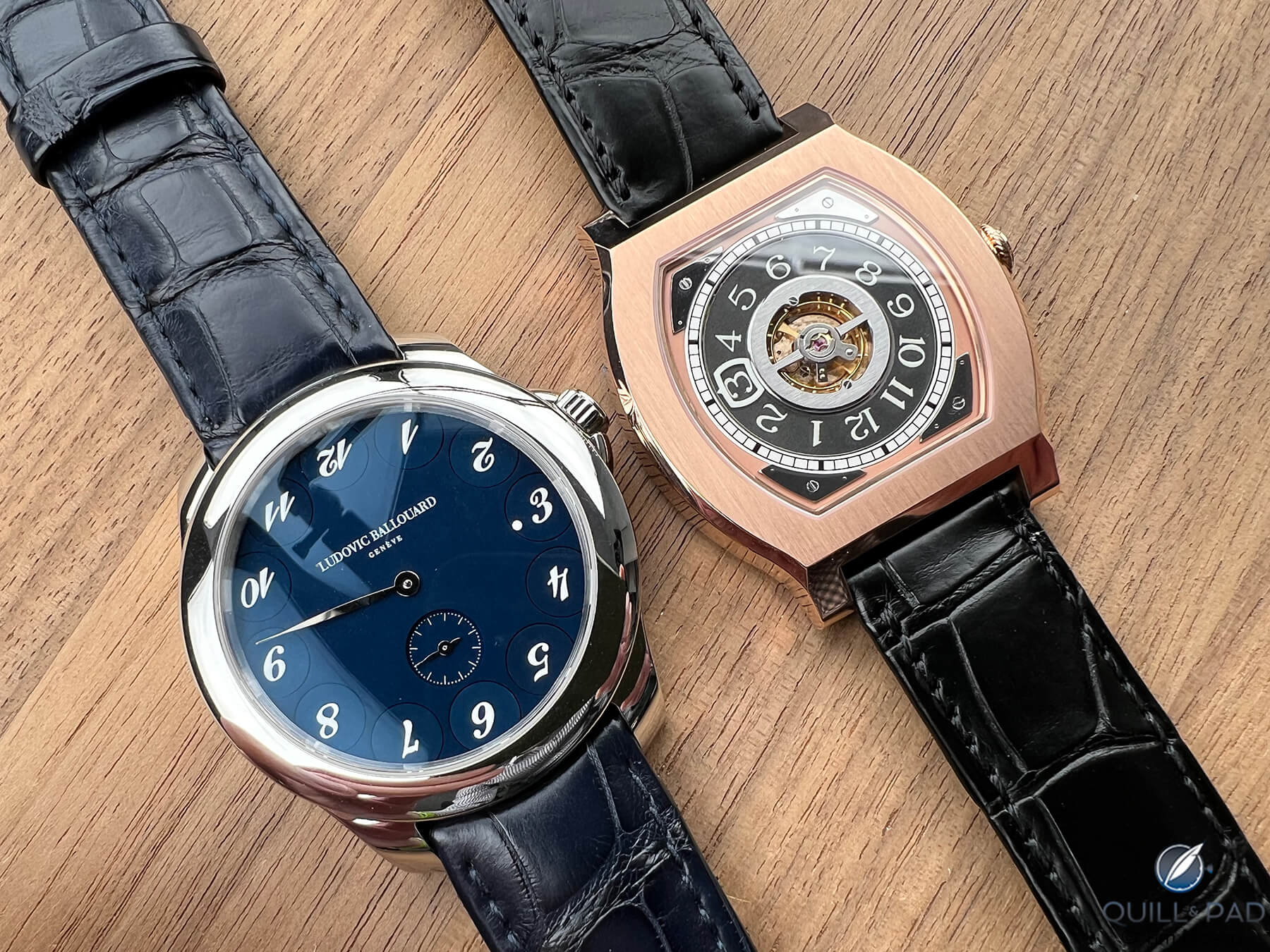
Ludovic Ballouard Upside Down (left) and F.P. Journe Vagabondage I
We choose these watches as much because we identify with their creators as any rational reason. The quiet and low-key Ballouard is more like me, and I see more of myself in him. I admire his low-volume dedication, his upbeat view of our short time on Earth, and the energy of his mechanized ballet. His watch would be my choice from among these two.
For more information, please visit www.fpjourne.com/en/event/events/vagabondage-i-gold-final-chapter-trilogy-started-18-years-ago and/or https://ballouard.com/upside-down/
Quick facts: Ludovic Ballouard Upside Down
Case: Platinum; 41mm diameter; 10.5mm thick; 47.5mm from lug-to-lug; 30-meters WR; 20mm between lug horns; push down crown
Clasp: Platinum pin buckle
Dial: Petrol Blue
Movement: Caliber B01, Peseux 7001 train geometry, manual wind with 36-hour power reserve; 3Hz, 51 jewels, Maltese crosses with snail cam jumper, 35mm in diameter
Functions: Rotating hours, minutes, seconds
2024 Retail Price: Approximately $100,000
2024 Pre Owned Price: $95,000-$100,000
Quick facts: F.P. Journe Vagabondage I Rose Gold
Reference Code: V
Edition number: 68 pieces
Case: 6N Red gold; 37.5mm diameter; 7.9mm thick; 45.2mm from lug-to-lug; 30-meters WR; 18.5mm between lug horns; push down crown
Clasp: Rose gold single folding clasp
Dial: Rose gold surround with polished steel plates; time scale encircling visible balance
Movement: Caliber 1504.2, manual wind with 50-hour power reserve; wandering hours, 18-karat rose gold bridges and plates, twin barrels in parallel, 3Hz, 21 jewels, five-position adjustment, 29.3mm x 28.2mm
Functions: Wandering hours with minutes
2024 Pre Owned Price: $280,000-$290,000
* Tim Mosso is the media director and watch specialist at Watchbox. You can check out his very comprehensive YouTube channel at www.youtube.com/@WatchBoxStudios/videos.
You might also enjoy:
Why I Bought It: Ludovic Ballouard Upside Down
Presenting ‘Making Time’: The Greatest Watch Film Ever Made (In My Extremely Biased Opinion)
Behind the Lens: The F.P. Journe Tourbillon Souverain

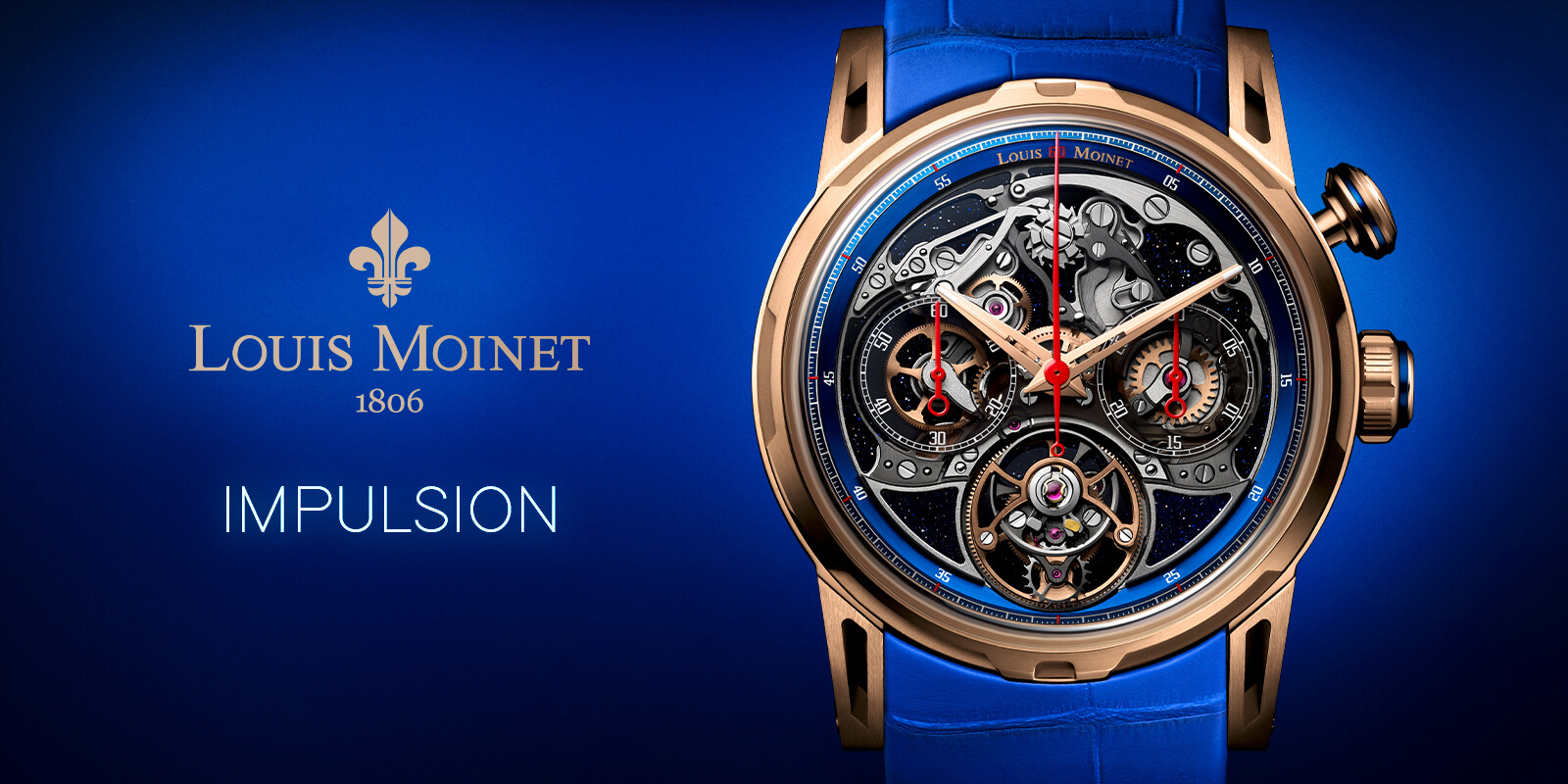
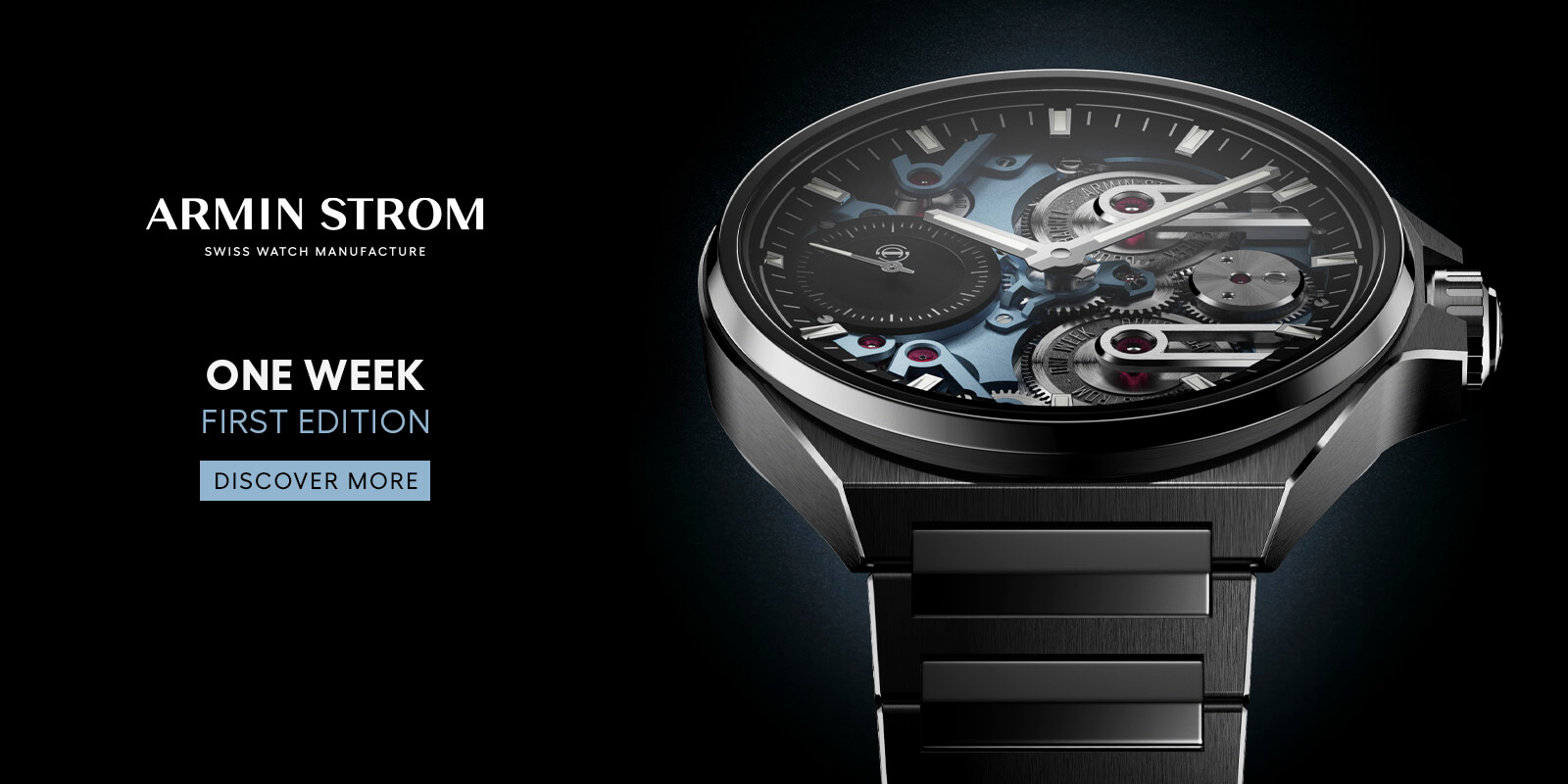
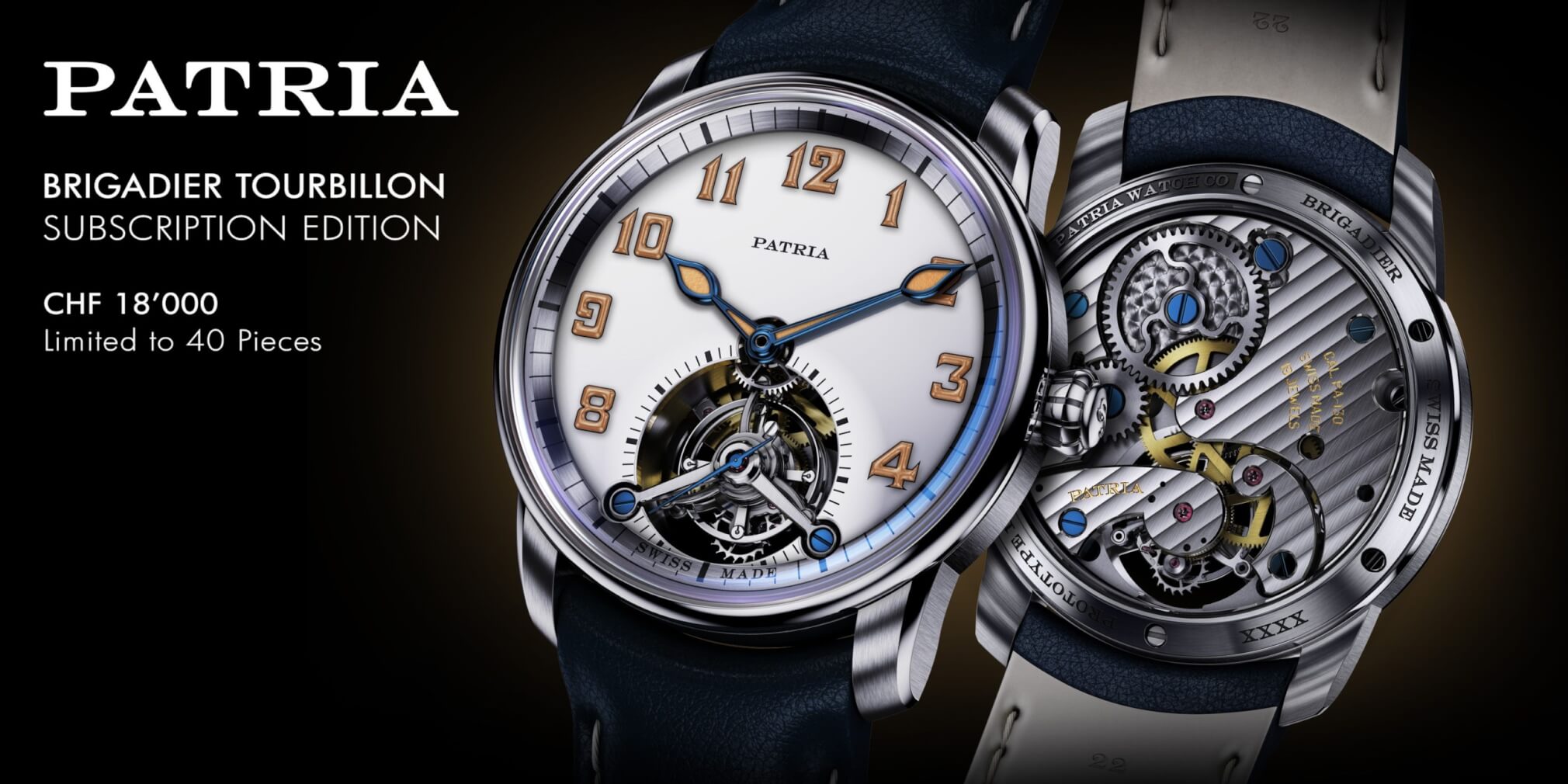


Leave a Reply
Want to join the discussion?Feel free to contribute!